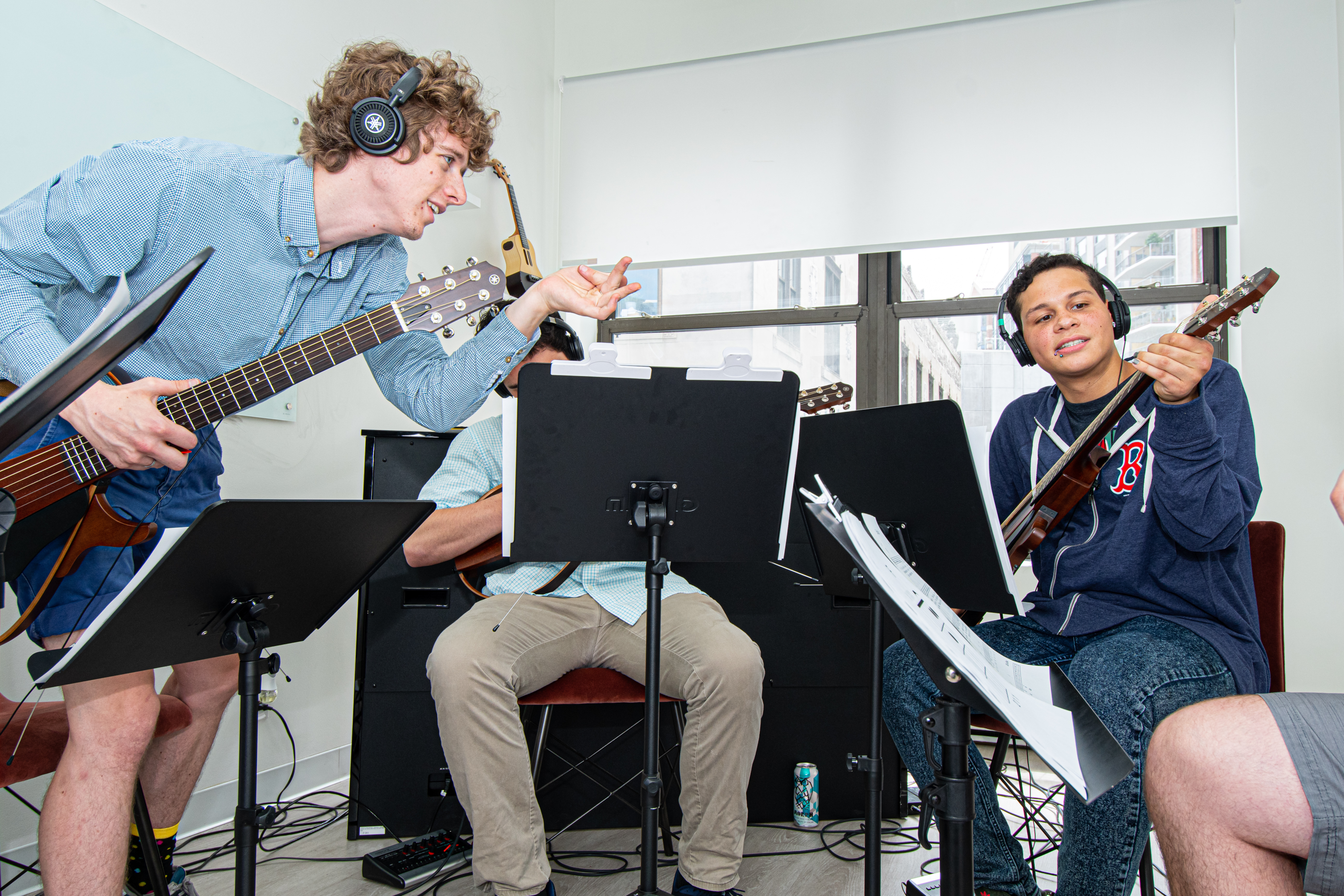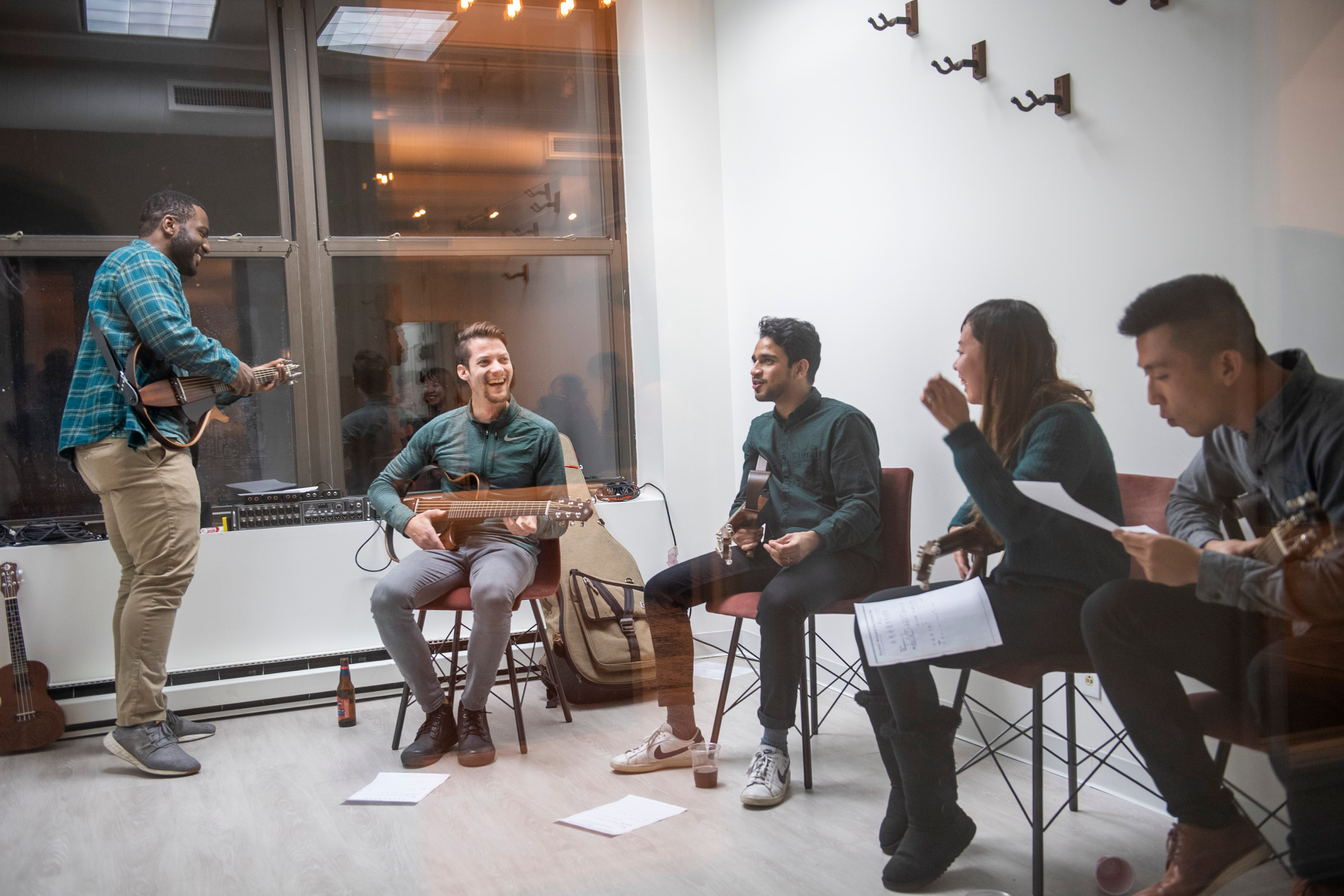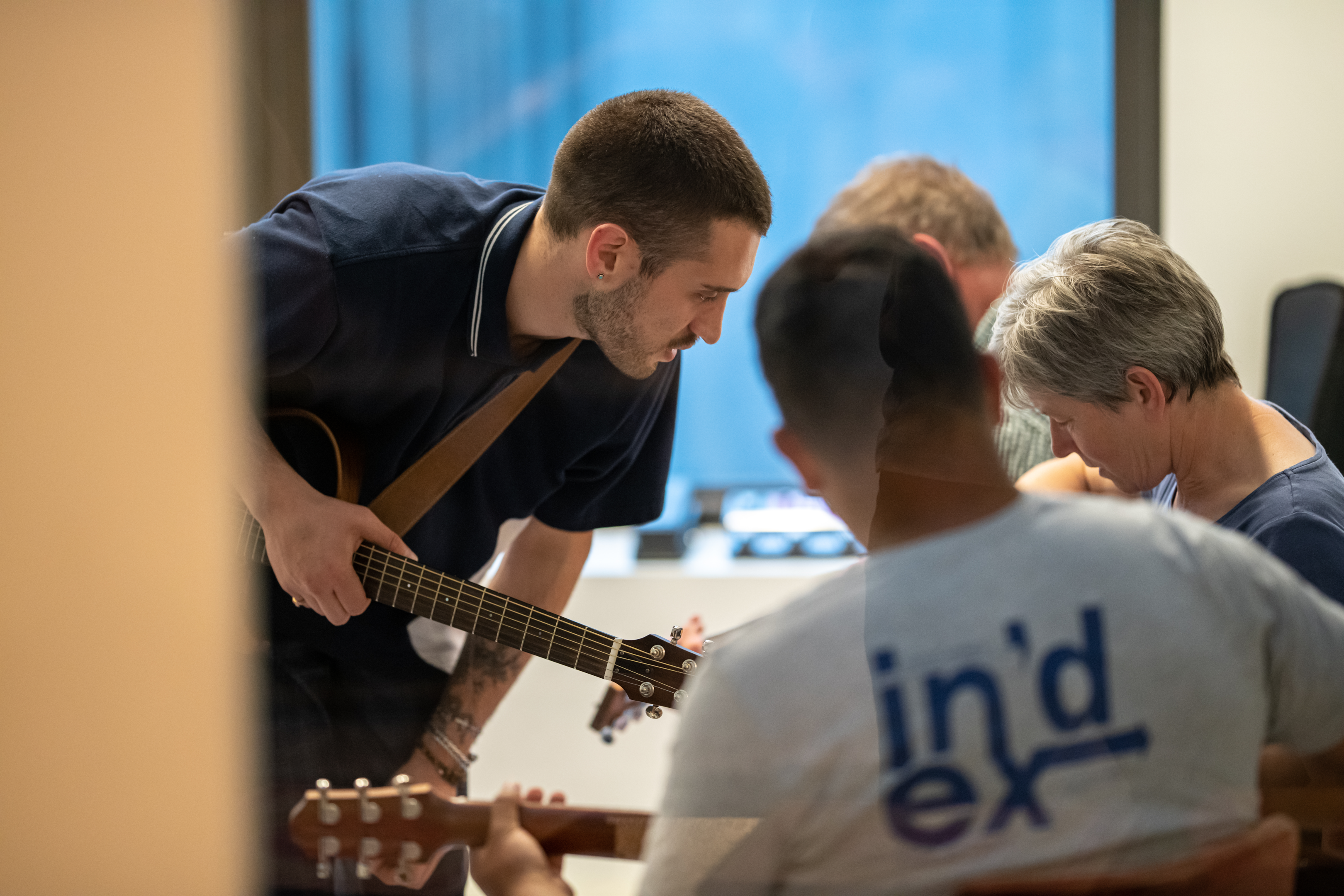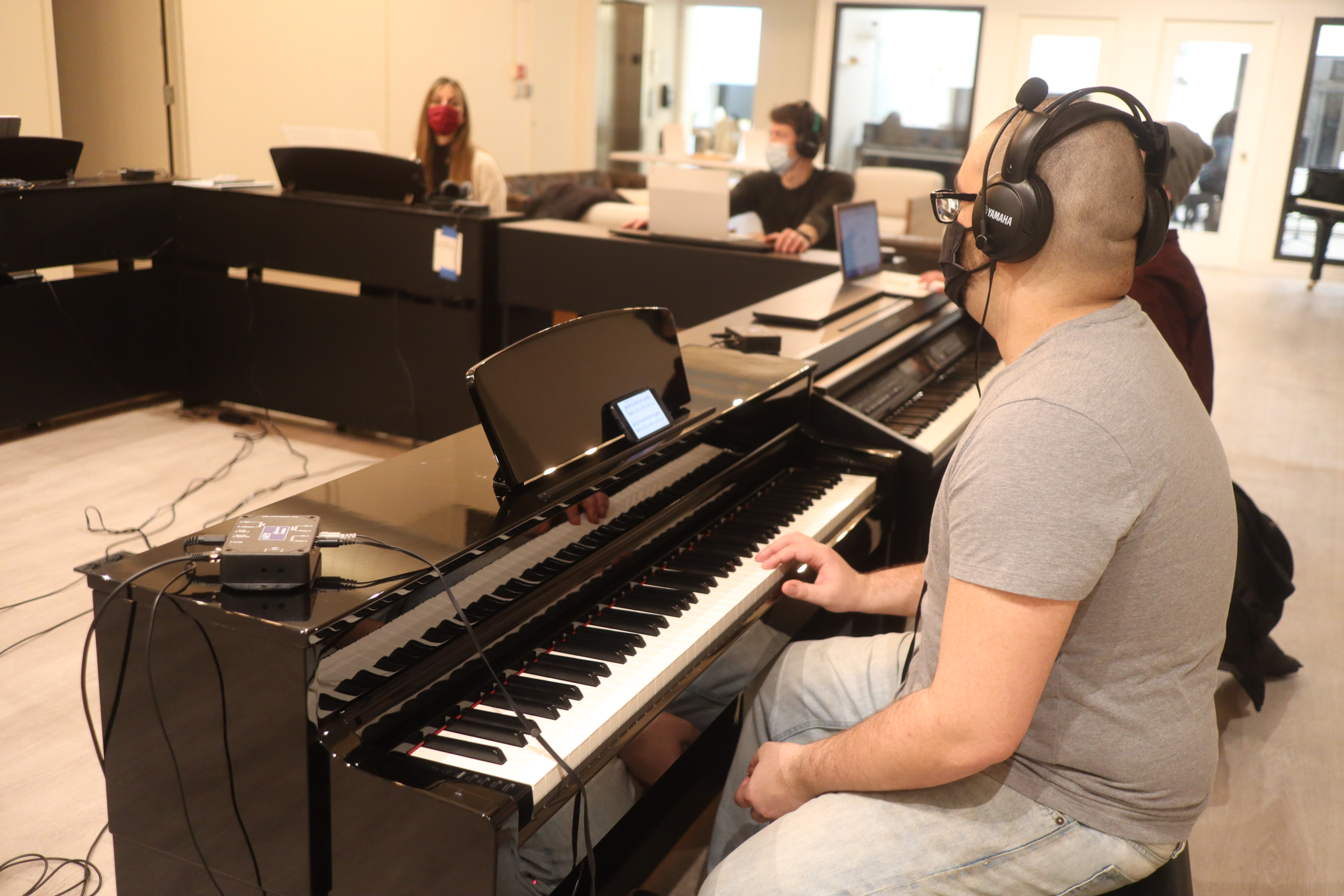Blog
Music Learning Apps Vs. Music Teachers – Which Are Better?

The use of technology has had a tremendous impact on our education. the internet has given us unlimited access to information and the interactive nature of tech has made learning more fun and engaging for students.
For musicians, music apps have made learning faster, more efficient, and more enjoyable – but is it possible to learn music on your own, or do you need the guidance of a music teacher in private lessons or even group classes in order to focus your learning and achieve your learning goals?
This article will explore the role of music apps in learning music, the many benefits of learning with a teacher, and how to know what balance is right for you when it comes to your personal musical journey.
Advancements in Music Technology
Music technology has advanced rapidly in recent years and musicians now have access to a wealth of resources that were once unimaginable – they can find, download and annotate sheet music, learn music theory, record and playback their own music, and even take online courses – all in a fun and interactive way, and from the comfort of their own home.
There are various types of tech available, such as music notation software, recording and editing tools, virtual instruments, and music apps that make it easier for students to read sheet music, practice their sight reading and ear training, learn how to play various instruments and sing, and build a repertoire of their favorite songs.
The Benefits of Technology-Based Music Learning:
This new technology offers several advantages to the musician:
Convenience: The student can open the music learning app at any time, and go at their own pace. The learning can be done from anywhere (it isn’t confined to the studio), and everything you need for your practice – be it sheet music, backing tracks, or chord charts – is located in one place – on your device. The learning can be done in the student’s free time and is more flexible.
Access to resources: Your devices are an endless well of resources (like Mary Poppins’ bottomless bag of stuff) and they give you access to vast sheet music libraries, interactive software, video tutorials on everything from music theory to things like “How to build an acoustic guitar from scratch”, and more. Also, some of the best apps are free to use, making these learning tools more accessible to students.
Personalized learning: Some adaptive music apps have the option to tailor the learning to students and their specific goals- MyEarTraining, for instance, allows you to choose what your specific focus is for the practice and provides exercises based on your specifications.
Collaborative learning: Technology-based music learning tools can also facilitate collaborative learning, as students can work together on projects using online collaboration tools, even if they are located in different parts of the world.
It’s fun and engaging: interactive music learning apps are built like a game, and the rewards cycle for “winning” can help students stay motivated. Also, music apps provide a casual, low-pressure learning environment, allowing learners to explore and develop their skills without external pressures to perform well.
Instant feedback: The app also provides quick feedback to the users as they go – if you play guitar, for instance, your app will help you tune it and let you know if played the right chord. If you’re singing, your microphone will pick up your voice and apps like SimplyVoice will tell you if you’re hitting the right pitch by providing a performance evaluation after you sing through the whole song. This is helpful when it comes to tracking your progress.

When Is My Music Learning App Not Enough?
While technology-based learning can be fun, convenient, and effective, there are some major drawbacks to learning music without an instructor and relying solely on music apps. Here are just some of the main disadvantages:
Limited Feedback: music apps can provide some feedback on your progress, but it may not be as comprehensive as the feedback that a teacher provides. For example, a piano learning app can only tell you if you nailed the chord progressions or not, whereas a teacher will be able to isolate the mistakes (maybe the transitions between chords aren’t clean enough), identify what caused them (for instance, the student is having a hard time transitioning between chords with both hands), and offer an exercise to help correct them (starting out with just the bass notes on the left hand, and working up to the whole chord, and finally using both hands.)
Lack of Personalized Instruction: An app can only provide personalized recommendations using an algorithm that’s based on the very limited input it receives from the user. It may not be able to tailor the instruction to a student’s specific learning style and needs as well as a teacher – who can see the student and assess their technique in real-time – can. Teachers can give more detailed feedback on technique, expression, and overall musicianship of a player, while an app can at best tell you if you played the notes correctly or incorrectly.
Incomplete Learning: The student might only do exercises that they’re comfortable with on music apps, and as a result, its algorithm will only pump out one type of exercise for them to try. A teacher can analyze their students’ learning styles and skill levels, and build a structured program for them that balances music theory, musicianship, technique, and repertoire. For instance, a voice teacher might notice that their student has no trouble hitting the right note, but is struggling to read music in rhythm (they might be confused by changes in the time signatures of the piece). They might then choose to incorporate more sight singing into future lessons, and less ear training, as that is the area in which the student needs support. An app wouldn’t pick up on specifics like this unless the student has elected to do sight singing exercises on their own.
Limited Interaction: Perhaps the most significant drawback of using only music apps to learn music. Learning music with an app can be a solitary experience, but music is collaborative! Playing songs in group classes and ensembles is a fun way to work on your collaborative skills, and to receive constructive feedback. Ensemble skills are an essential part of musicianship, and you can’t develop them if you only play music on your own.
Lack of specificity: A self-learning app can provide a wealth of information, but it rarely provides a complete learning experience. With the countless resources available online, it’s challenging for learners to filter through and find the most relevant and effective materials for their needs. A teacher can help with that filtering and provide a more comprehensive education, including relevant music theory, performance techniques, songs with difficult passages that work on a specific learning objective the student is tackling, and more.
Lack of Accountability: This is a common issue in self-directed learning. Without a teacher, students may not have the same level of accountability and motivation to practice and improve and will find it difficult to get started or set goals that are challenging enough. A teacher can provide this accountability by assigning the student songs to learn and setting a deadline, thus making sure the students are moving through their learning objectives at a reasonable pace.
What’s Right For Me?
Here at Musicians Playground, we believe that while learning through an app alone is not enough – technology is a great tool that can be used to supplement the work done in the lessons with our instructors. Finding the right balance is tricky, but here are some guidelines to help you with that:
Getting The Best of Both Worlds:
Combining self-learning apps with the guidance of a teacher can be an effective way to maximize progress in your learning. Here are some specific examples of how this can be done:
Use an app to supplement lessons: This can provide additional resources and exercises that can complement your private lessons. For example, if you want to learn guitar, a guitar teacher may assign the student songs to learn and then suggest specific exercises on an app like simply guitar that can help the student improve their technique or speed.
Use an app for Practice: You can use an app to practice outside of your lessons – even the free ones are excellent. For example, you could use a music theory app to reinforce concepts learned in class, or a metronome app to practice playing in time.
Progress Tracking: Music learning apps can track a student’s progress and provide data that the music teacher can use to tailor their lessons. For example, you can use an ear training app like MyEarTraining to practice identifying chords and intervals – it can track your performance on quizzes and provide a report on the areas where you need more support
Feedback: You can share the feedback provided by the app with your instructor, and they can use that feedback to supplement their own notes for you.
Integration: Your teacher can integrate the best tools from an app they like (games, lessons, and exercises) into their curriculum. For example, a free music theory app may have a fun sight-reading game, which the teacher can use in their lessons to help their student read music.
Importance of Specificity in Achieving Your Goals

While an app has the potential to be a fun, engaging, and casual form of learning, a music teacher provides specific and personalized instruction, adapts the curriculum to the learner’s goals, and offers valuable feedback and guidance to ensure progress and growth. Both will work great, but truly efficient progress is achieved through specific focus. If you’re looking to make great progress, tech is a great supplement to a teacher’s guidance, but there’s no substitute for a teacher.
How We Do it at Musicians Playground:
At MP we believe in integrating tech into music education – Our instrumental group lessons in piano and guitar use a unique lab system that allows for isolation through a headset – that way a group class can have students at multiple skill levels participating in it and the experience feels like a private lesson. The same system is used to isolate a musician who is doing practice time at the studio, so they can play freely.
We encourage the use of laptops and tablets for the sheet music we read from in class and use digital journals to track students’ goals and progress. We also suggest that our students make use of digital libraries like Music Notes to find their own sheet music for private lessons or practice at home.
Another thing our teachers will do is make selections of the best apps for students based on their needs & help customize their settings according to the student’s level.

So – Do I Need a Teacher? (App-solutely!)
The digital age has significantly impacted music education, and throughout this article, we discussed many of the benefits of the use of technology for learning. However, the abundance of information available to us through this new technology is overwhelming, and it’s hard for learners to filter what is relevant to them and what isn’t.
This is why a teacher’s guidance is valuable and cannot be overstated: Whether you’re learning piano or just starting to get familiar with music theory – if you’re looking to achieve a specific goal, it’s essential to work with an instructor.
A balanced approach that combines both technology and teacher-based learning is effective for achieving a comprehensive music education experience. By utilizing the strengths of both technology and personalized instruction, you can enjoy a well-rounded, engaging, and dynamic journey in your music education.
Was this article helpful? If so – we post similar content monthly in our Musicians Playground newsletters, so consider signing up for our mailing list! That way, you can also stay updated on any upcoming events we have in the studio. Finally, if you’re ready to start your musical journey, reach out to us and we’ll help get you started. Happy learning!

